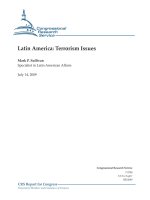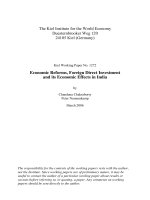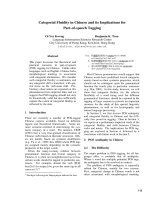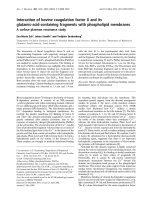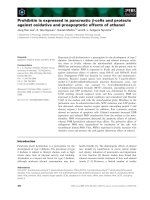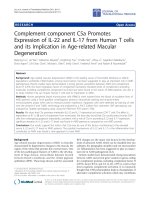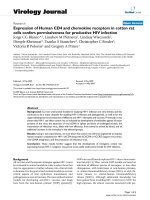Substance p chemokine interaction in mouse pancreatic acinar cells, and its implications in acute pancreatitis
Bạn đang xem bản rút gọn của tài liệu. Xem và tải ngay bản đầy đủ của tài liệu tại đây (4.41 MB, 237 trang )
SUBSTANCE P CHEMOKINE INTERACTION IN
MOUSE PANCREATIC ACINAR CELLS, AND ITS
IMPLICATIONS IN ACUTE PANCREATITIS
RAINA DEVI RAMNATH
NATIONAL UNIVERSITY OF SINGAPORE
2008
SUBSTANCE P CHEMOKINE INTERACTION IN
MOUSE PANCREATIC ACINAR CELLS, AND ITS
IMPLICATIONS IN ACUTE PANCREATITIS
RAINA DEVI RAMNATH
(B.Sc. NUS)
A THESIS SUBMITTED FOR THE DEGREE OF
DOCTOR OF PHILOSOPHY
DEPARTMENT OF PHARMACOLOGY
NATIONAL UNIVERSITY OF SINGAPORE
2008
i
ACKNOWLEDGEMENTS
I would like to express my gratitude to my supervisor, Associate Professor Madhav
Bhatia, for having given me the opportunity to do my graduate studies. I also want to
thank him for his invaluable guidance, support, advice and patience.
I would like to extend my appreciation to the National University of Singapore, for
providing a conducive and exciting research environment.
My thanks go to the Lab officer Miss Shoon Mei Leng as well as all my friends in the
university.
I am grateful to my family for their unfailing love, affection and support.
I would also like to convey a special acknowledgement to all the animals sacrificed
during the course of my study.
Thank you God!
ii
TABLE OF CONTENTS Page
ACKNOWLEDGEMENTS i
SUMMARY ix
LIST OF FIGURES xii
LIST OF ABBREVIATIONS xv
LIST OF ORIGINAL REPORTS xvii
LIST OF INTERNATIONAL CONFERENCE PRESENTATIONS xix
CHAPTER 1: GENERAL INTRODUCTION 1
1.1 ACUTE PANCREATITIS 1
1.2 INTRA-ACINAR EVENTS IN ACUTE PANCREATITIS 3
1.3 PATHOPHYSIOLOGY OF ACUTE PANCREATITIS IN ACINAR CELLS 4
1.4 SUBSTANCE P 5
1.4.1 Substance P in Acute Pancreatitis 6
1.5 CHEMOKINES 7
1.5.1 Chemokines in Acute Pancreatitis 8
1.6 TEST SYSTEM: IN VITRO MODEL 9
1.7 TEST SYSTEM: IN VIVO MODEL 10
1.8 NUCLEAR FACTOR κ B (NFκB) 11
1.9 ACTIVATOR PROTEIN-1 (AP-1) 14
1.10 MITOGEN-ACTIVATED PROTEIN KINASES (MAPKs) 15
1.11 PHOSPHOLIPASE C 17
1.12 PROTEIN KINASE C (PKC) 18
1.13 CALCIUM 20
1.14 SRC FAMILY KINASES (SFKs) 20
iii
1.15 SIGNAL TRANSDUCERS AND ACTIVATORS OF TRANSCRIPTION (STAT) 3 22
1.16 HYPOTHESIS AND AIMS 23
CHAPTER 2: SUBSTANCE P TREATMENT STIMULATES CHEMOKINE
SYNTHESIS IN MOUSE PANCREATIC ACINAR CELLS VIA THE
ACTIVATION OF NFκB 25
2.1 INTRODUCTION
25
2.2 MATERIALS AND METHODS
27
2.2.1 ANIMAL ETHICS 27
2.2.2 PREPARATION OF MOUSE PANCREATIC ACINI 27
2.2.3 VIABILITY OF MOUSE PANCREATIC ACINAR CELLS 28
2.2.4 IN VITRO TREATMENT WITH SUBSTANCE P 28
2.2.5 CHEMOKINE DETECTION 28
2.2.6 PREPARATION OF NUCLEAR CELL EXTRACT 29
2.2.7 NFκB DNA-BINDING ACTIVITY 29
2.2.8 NFκB INHIBITION 30
2.2.9 PREPARATION OF TOTAL CELL LYSATES 30
2.2.10 WESTERN BLOT ANALYSIS 30
2.2.11 AMYLASE ESTIMATION 31
2.2.12 STATISTICAL ANALYSIS 32
2.3 RESULTS
33
2.3.1 SUBSTANCE P INDUCES CHEMOKINE PRODUCTION IN MOUSE
PANCREATIC ACINAR CELLS IN A CONCENTRATION-DEPENDENT MANNER 33
2.3.2 SUBSTANCE P OR CAERULEIN INDUCES NFκB ACTIVATION IN MOUSE
PANCREATIC ACINAR CELLS 33
2.3.3 SUBSTANCE P OR CAERULEIN-INDUCED CHEMOKINE SYNTHESIS IS
PREVENTED BY NEMO-BINDING DOMAIN PEPTIDE (NBD), AN NFκB
INHIBITOR 34
2.3.4 SUBSTANCE P AND CAERULEIN MAY ACT VIA DISTINCT PATHWAYS IN
INDUCING CHEMOKINE SYNTHESIS 34
iv
2.3.5 EFFECT OF SUBSTANCE P TREATMENT ON AMYLASE SECRETION IN
MOUSE PANCREATIC ACINAR CELLS 35
2.4 DISCUSSION
36
CHAPTER 3: EFFECT OF MITOGEN-ACTIVATED PROTEIN KINASES ON
CHEMOKINE SYNTHESIS INDUCED BY SUBSTANCE P IN MOUSE
PANCREATIC ACINAR CELLS 49
3.1 INTRODUCTION
49
3.2 MATERIALS AND METHODS
52
3.2.1 ANIMAL ETHICS 52
3.2.2 PREPARATION OF MOUSE PANCREATIC ACINI 52
3.2.3 VIABILITY OF MOUSE PANCREATIC ACINAR CELLS 52
3.2.4 CELL SIGNALING EXPERIMENTS 52
3.2.5 PREPARATION OF CELL LYSATES FOR WESTERN BLOT ANALYSIS 53
3.2.6 WESTERN BLOT ANALYSIS 54
3.2.7 PREPARATION OF NUCLEAR CELL EXTRACT 54
3.2.8 NFκB DNA-BINDING ACTIVITY 54
3.2.9 AP-1 DNA-BINDING ACTIVITY 54
3.2.10 CHEMOKINE DETECTION 55
3.2.11 STATISTICAL ANALYSIS 55
3.3 RESULTS
56
3.3.1 SUBSTANCE P STIMULATES ERK1/2 PHOSPHORYLATION AND NFκB
ACTIVATION IN A TIME-DEPENDENT MANNER 56
3.3.2 ERK1/2-MEDIATED NFκB ACTIVATION IS INVOLVED IN SUBSTANCE P-
INDUCED CHEMOKINE SYNTHESIS 56
3.3.3 SUBSTANCE P INDUCES PHOSPHORYLATION OF JNK AND AP-1
ACTIVATION IN A TIME DEPENDENT MANNER 57
3.3.4 INVOLVEMENT OF JNK IN SUBSTANCE P-INDUCED AP-1 ACTIVATION
AND CHEMOKINE SYNTHESIS 58
3.3.5 SUBSTANCE P-INDUCED ERK1/2 AND JNK CROSS ACTIVATE NFκB AND
AP-1 59
v
3.3.6 SUBSTANCE P/NK1R INTERACTION IS INVOLVED IN ERK 1/2 AND JNK
ACTIVATION 59
3.3.7 SUBSTANCE P-INDUCED NFκB AND AP-1 ACTIVATION AS WELL AS
CHEMOKINE PRODUCTION ARE MEDIATED THROUGH NK1R 59
3.4 DISCUSSION
61
CHAPTER 4: ROLE OF PROTEIN KINASE C δ ON SUBSTANCE P-INDUCED
CHEMOKINE SYNTHESIS IN MOUSE PANCREATIC ACINAR CELLS 88
4.1 INTRODUCTION
88
4.2 MATERIALS AND METHODS
90
4.2.1 ANIMAL ETHICS 90
4.2.2 PREPARATION OF MOUSE PANCREATIC ACINI 90
4.2.3 VIABILITY OF MOUSE PANCREATIC ACINAR CELLS 90
4.2.4 ACINAR EXPERIMENTAL PROTOCOL 90
4.2.5 IMMUNOFLUORESCENCE 91
4.2.6 PREPARATION OF TOTAL CELL LYSATES FOR WESTERN BLOT
ANALYSIS 91
4.2.7 WESTERN BLOT ANALYSIS 92
4.2.8 NUCLEAR CELL EXTRACT PREPARATION 92
4.2.9 NFκB DNA-BINDING ACTIVITY 92
4.2.10 AP-1 DNA-BINDING ACTIVITY 93
4.2.11 TOTAL RNA ISOLATION 93
4.2.12 SEMIQUANTITATIVE RT-PCR 93
4.2.13 CHEMOKINE DETECTION 94
4.2.14 STATISTICAL ANALYSIS 94
4.3 RESULTS
95
4.3.1 SUBSTANCE P INDUCES PHOSPHORYLATION OF PKCδ IN A TIME
DEPENDENT MANNER 95
4.3.2 SUBSTANCE P STIMULATES ACTIVATION OF MEKK1 IN A TIME
DEPENDENT MANNER 95
vi
4.3.3 SUBSTANCE P-INDUCED PKCδ IS INVOLVED IN ACTIVATION OF
MEKK1, ERK AND JNK 96
4.3.4 PKCδ IS INVOLVED IN SUBSTANCE P-INDUCED NFκB AND AP-1
ACTIVATION 96
4.3.5 EFFECT OF PKCδ INHIBITORS ON THE GENE EXPRESSION AND
SECRETION OF SEVERAL PRO-INFLAMMATORY CHEMOKINES IN
PANCREATIC ACINAR CELLS 97
4.3.6 SUBSTANCE P /NK1R INTERACTION IS INVOLVED IN PKCδ AND MEKK1
ACTIVATION 97
4.4 DISCUSSION
99
CHAPTER 5: ROLE OF CALCIUM AND CONVENTIONAL PROTEIN KINASE
C α/βII IN SUBSTANCE P-INDUCED CHEMOKINE SYNTHESIS IN MOUSE
PANCREATIC ACINAR CELLS 120
5.1 INTRODUCTION
120
5.2 MATERIALS AND METHODS
122
5.2.1 ANIMAL ETHICS 122
5.2.2 TEST SYSTEM USED 122
5.2.3 VIABILITY OF MOUSE PANCREATIC ACINAR CELLS 122
5.2.4 EXPERIMENTAL DESIGN 122
5.2.5 PREPARATION OF TOTAL CELL LYSATES FOR WESTERN BLOT
ANALYSIS 123
5.2.6 WESTERN BLOT ANALYSIS 123
5.2.7 NUCLEAR CELL EXTRACT PREPARATION 124
5.2.8 NFκB DNA-BINDING ACTIVITY 124
5.2.9 AP-1 DNA-BINDING ACTIVITY 124
5.2.10 CHEMOKINE DETECTION 124
5.2.11 CYTOSOLIC CALCIUM MEASUREMENT 124
5.2.12 STATISTICAL ANALYSIS 124
5.3 RESULTS
126
vii
5.3.1 SUBSTANCE P INDUCES PHOSPHORYLATION OF PKCα/βII IN A TIME
DEPENDENT MANNER 126
5.3.2 SUBSTANCE P-INDUCED [Ca
2+
]i IS INVOLVED IN ACTIVATION OF
PKCα/βII, ERK AND JNK 126
5.3.3 ROLE OF PLC IN SUBSTANCE P-INDUCED ACTIVATION OF PKCα/βII,
ERK AND JNK IN PANCREATIC ACINAR CELLS 127
5.3.4 PLC AND Ca
2+
ARE INVOLVED IN SUBSTANCE P-INDUCED NFκB p65
AND AP-1 c-Jun ACTIVATION IN PANCREATIC ACINAR CELLS 127
5.3.5 PLC, Ca
2+
AND PKC ARE INVOLVED IN THE SECRETION OF SEVERAL
PRO-INFLAMMATORY CHEMOKINES IN PANCREATIC ACINAR CELLS 127
5.4 DISCUSSION
129
CHAPTER 6: INVOLVEMENT OF SRC FAMILY KINASES IN SUBSTANCE P-
INDUCED CHEMOKINE PRODUCTION IN MOUSE PANCREATIC ACINAR
CELLS, AND ITS SIGNIFICANCE IN ACUTE PANCREATITIS 148
6.1 INTRODUCTION
148
6.2 MATERIALS AND METHODS
151
6.2.1 ANIMAL ETHICS 151
6.2.2 TEST SYSTEM USED 151
6.2.3 VIABILITY OF MOUSE PANCREATIC ACINAR CELLS 151
6.2.4 IN VITRO EXPERIMENTAL DESIGN 151
6.2.5 PREPARATION OF TOTAL CELL LYSATES FOR WESTERN BLOT
ANALYSIS 152
6.2.6 WESTERN BLOT ANALYSIS 152
6.2.7 NUCLEAR EXTRACT PREPARATION 153
6.2.8 STAT3 DNA-BINDING ACTIVITY 153
6.2.9 NFκB DNA-BINDING ACTIVITY 153
6.2.10 AP-1 DNA-BINDING ACTIVITY 153
6.2.11 CHEMOKINE DETECTION 154
6.2.12 INDUCTION OF ACUTE PANCREATITIS 154
6.2.13 AMYLASE ESTIMATION 154
viii
6.2.14 MYELOPEROXIDASE ESTIMATION 155
6.2.15 MORPHOLOGICAL EXAMINATION 155
6.2.16 STATISTIC 156
6.3 RESULTS
157
6.3.1 SUBSTANCE P/NK1R INDUCES A TIME DEPENDENT INCREASE AND
DECREASE IN PHOSPHORYLATION OF SFK IN MOUSE PANCREATIC ACINAR
CELLS 157
6.3.2 INVOLVEMENT OF SFK IN SUBSTANCE P-INDUCED MAP KINASES IN
PANCREATIC ACINAR CELLS 157
6.3.3 SUBSTANCE P- INDUCED SFK IS INVOLVED IN ACTIVATION OF STAT3,
NFκB AND AP-1 IN PANCREATIC ACINAR CELLS 158
6.3.4 SFK MEDIATES SUBSTANCE P-INDUCED PRODUCTION OF CC AND CXC
CHEMOKINES IN PANCREATIC ACINAR CELLS 158
6.3.5 EFFECT OF PROPHYLACTIC AND THERAPEUTIC TREATMENT WITH PP2
ON THE SEVERITY OF CAERULEIN-INDUCED ACUTE PANCREATITIS 159
6.3.6 INVOLVEMENT OF SFK IN THE MOBILIZATION OF NEUTROPHILS AND
CHEMOKINES IN ACUTE PANCREATITIS 159
6.3.7 INHIBITION OF SFK ATTENUATED THE ACTIVATION OF PANCREATIC
STAT3, NFκB, AP-1 AND MAP KINASES IN ACUTE PANCREATITIS 160
6.4 DISCUSSION
161
CHAPTER 7: CONCLUSIONS AND IMPLICATIONS 188
REFERENCES 193
ix
SUMMARY
Background: Acute pancreatitis is increasing in incidence and can be a fatal human
disease, in which the pancreas digests itself and its surroundings. Inflammatory mediators
such as substance P and chemokines have been shown to be critically involved in the
pathogenesis of acute pancreatitis.
Aim: To investigate the functional consequences of exposing pancreatic acinar cells to
the neuropeptide substance P and determine if it leads to pro-inflammatory signaling such
as production of chemokines. Moreover, to investigate the mechanisms through which
substance P mediates pro-inflammatory signaling in mouse pancreatic acinar cells.
Furthermore, to test the significance of my in vitro findings in a more complex in vivo
model of acute pancreatitis.
Results: Exposure of mouse pancreatic acini to substance P significantly increased
synthesis of the CC chemokines MCP-1, MIP-1α and the CXC chemokine MIP-2.
Furthermore, substance P increased NFκB activation. Blockade of the NFκB pathway
significantly attenuated chemokine production, thus demonstrating that substance P-
induced chemokine synthesis in mouse pancreatic acinar cells is NFκB dependent.
Substance P also induced activation of MAP Kinases ERK and JNK as well as the
transcription factor AP-1. Both ERK and JNK were found to be essential for NFκB and
AP-1 activation, resulting in increased chemokine production. Moreover, CP96345, a
selective substance P receptor (NK1R) antagonist, attenuated the activation of ERK,
JNK, NFκB and AP-1 mediated chemokine production, hence showing that chemokine
production is dependent on substance P/NK1R in pancreatic acinar cells.
x
I also showed that substance P stimulated an early phosphorylation of the novel PKC
isoform PKCδ, followed by an increased activation in MEKK1, ERK, JNK as well as
NFκB and AP-1 driven chemokine production. Depletion of PKCδ decreased the
activation of PKCδ, MEKK1, ERK, JNK, NFκB, AP-1 and chemokine production.
Besides, PKCδ activation was attenuated by CP96345, hence showing that PKCδ
activation was indeed mediated by substance P/NK1R in pancreatic acinar cells.
In addition, substance P stimulated the activation of conventional PKCα/βII which was
mediated by PLC. Besides activating PKCα/βII, substance P-induced PLC increased
intracellular mobilization of [Ca
2+
] in pancreatic acinar cells. The increase in [Ca
2+
]i
resulted in the phosphorylation of PKCα/βII, ERK and JNK; consequently leading to the
activation of NFκB, AP-1 and ultimately to chemokine production.
Substance P/NK1R also induced a transient increase in the activation of Src family
kinases (SFKs) in pancreatic acinar cells. Moreover, substance P-induced SFKs mediated
the activation of ERK and JNK, transcription factors STAT3, NFκB and AP-1 as well as
MCP-1, MIP-1α and MIP-2 in vitro. Blockade of SFKs, both prophylactically and
therapeutically, reduced the severity of acute pancreatitis in vivo as evidenced by a
significant attenuation of hyperamylasemia, pancreatic MPO activity, pancreatic
chemokine levels and pancreatic water content. Moreover, histological evidence of
diminished pancreatic injury confirmed the protective effect of the inhibition of SFKs on
acute pancreatitis.
Conclusions and Implications: Substance P induces chemokine synthesis in pancreatic
acinar cells. The proposed signaling pathway through which substance P mediates acute
pancreatitis is through substance P/NK1R - (PLC-PKCα/βII-Ca
2+
)/(PKCδ-
xi
MEKK1)/(SFKs) - (ERK, JNK) - (STAT3, NFκB, AP-1) - (MCP-1, MIP-1α, MIP-2). A
deeper understanding of the mechanisms by which substance P modulates its downstream
functions will facilitate the discovery and development of novel therapeutic approaches
that can target selective pathways to prevent disease progression in acute pancreatitis
and/or improve treatment efficacy.
xii
LIST OF FIGURES
FIGURE
TITLE PAGE
1.1 Inflammatory mediators in the pathogenesis of acute pancreatitis
3
1.2 Classical pathway of NFκB activation
13
1.3
A typical MAPK cascade 16
1.4 PLC signaling pathway
18
2.1 Substance P induces chemokine production in a concentration-
dependent manner in mouse pancreatic acinar cells
40
2.2 Substance P or caerulein induces NFκB activation in mouse
pancreatic acinar cells
42
2.3 Substance P (SP) or caerulein-induced chemokine synthesis is
abolished with NEMO-Binding Domain peptide (NBD), an NFκB
inhibitor
44
2.4 Substance P (SP) and caerulein act independently in inducing
chemokine synthesis
46
2.5 Amylase secretion
48
3.1 Substance P stimulates ERK1/2 phosphorylation and NFκB
activation in a time-dependent manner
65
3.2 PD98059 decreases phosphorylation of ERK1/2 in pancreatic acini
68
3.3 ERK1/2-mediated NFκB activation is involved in substance P-
induced chemokine synthesis
70
3.4 Substance P induces phosphorylation of JNK and AP-1 activation in
a time-dependent manner
73
3.5 SP600125 decreases phosphorylation of JNK in pancreatic acini
75
3.6 JNK is involved in substance P-induced AP-1 activation and
chemokines synthesis
77
xiii
3.7 Substance P-induced ERK1/2 and JNK cross activate NFκB and AP-
1
80
3.8 Substance P/NK1R interaction is involved in ERK1/2 and JNK
activation
82
3.9 NK1R is involved in substance P-induced NFкB and AP-1
activation as well as MCP-1, MIP-1α and MIP-2 production
85
4.1 Substance P (SP) induces phosphorylation of PKCδ in a time
dependent manner
104
4.2 Substance P (SP) stimulates activation of MEKK1 in a time
dependent manner
106
4.3 Substance P (SP)-induced PKCδ is involved in activation of
MEKK1, ERK and JNK
107
4.4 PKCδ is involved in substance P (SP)-induced NFκB and AP-1
activation
112
4.5 PKCδ is involved in substance P (SP)-induced MCP-1, MIP-1α and
MIP-2 mRNA expression
114
4.6 PKCδ is involved in substance P (SP)-induced MCP-1, MIP-1α and
MIP-2 secretion
116
4.7 Substance P (SP)/NK1R interaction is involved in PKCδ and
MEKK1 activation
118
5.1 Substance P (SP) induces phosphorylation of PKCα/βII in a time
dependent manner
132
5.2 Substance P (SP) induces mobilization of [Ca
2+
]i in pancreatic
acinar cells
133
5.3 Substance P (SP)-induced [Ca
2+
]i is involved in activation of
PKCα/βII, ERK and JNK
135
5.4 Substance P (SP)-induced activation of PKCα/βII, ERK and JNK is
mediated by PLC in pancreatic acinar cells
139
5.5 PLC and Ca
2+
are involved in substance P (SP)-induced NFκB p65
and AP-1 c-Jun activation in pancreatic acinar cells
143
xiv
5.6 PLC, Ca
2+
and PKC are involved in the secretion of several pro-
inflammatory chemokines in pancreatic acinar cells
145
6.1 Substance P (SP)/NK1R induces a time dependent increase and
decrease in phosphorylation of Src family (Tyr 416) in mouse
pancreatic acinar cells
166
6.2 Substance P (SP)-induced activation of ERK and JNK is mediated
by SFKs in pancreatic acinar cells
168
6.3 SFKs are involved in substance P (SP)-induced STAT3, NFκB and
AP-1 activation in pancreatic acinar cells
172
6.4 SFKs are involved in the secretion of CC and CXC chemokines in
pancreatic acinar cells
174
6.5 Effects of prophylactic and therapeutic PP2 administration on the
severity of acute pancreatitis
176
6.6 Morphological changes in mouse pancreas on induction of acute
pancreatitis with/without prophylactic and therapeutic treatment
with PP2 or PP3
179
6.7 Involvement of SFKs in the mobilization of pancreatic neutrophils
and chemokines in acute pancreatitis
181
6.8 Inhibition of SFKs attenuated the activation of pancreatic STAT3,
NFκB, AP-1 and MAP Kinases in acute pancreatitis
184
7.1 The proposed cascades through which substance P stimulates the
production of chemokines in acute pancreatitis
191
xv
LIST OF ABBREVIATIONS
AP Acute pancreatitis
AP-1 Activator protein-1
bp Base pair(s)
BSA Bovine serum albumin
[Ca
2+
]i Intracellular calcium concentration
CCK Cholecystokinin
cDNA Complementary deoxyribose nucleic acid
CINC Cytokine-induced neutrophil chemoattractant
DMSO Dimethyl sulfoxide
ECL Enhanced chemiluminescence
EDTA Ethylenediaminetetraacetic
ELISA Enzyme-linked immunosorbent assay
GDP Guanosine diphosphate
GPCRs G protein coupled receptors
GRO-α Growth-related oncogene-alpha
GTP Guanosine triphosphate
HEPES N-2-hydroxyethylpiperazine-N’-2- ethanesulfonic acid
HPRT Hypoxanthine-guanine phosphoribosyl transferase
i.p. Intraperitoneal
IL Interleukin
IκB I kappa B
kDa Kilodalton
MAPK Mitogen-activated protein kinase
MCP Monocyte chemoattractant protein
MEK Mitogen-activated protein kinase Kinase
MEKK1 Mitogen-activated protein kinase Kinase kinase
MIP-1α Macrophage inflammatory protein-1 alpha
MIP-2 Macrophage inflammatory protein-2
MODS Multi organ dysfunction syndromes
MPO Myeloperoxidase
mRNA Messenger ribose nucleic acid
NEMO NFκB essential modifier
NFκB Nuclear factor kappa B
NK1R Neurokinin1 receptor
PBS Phosphate-buffered saline
PBST 0.05% Tween-20 in PBS
PCR Polymerase chain reaction
p-ERK Phosphorylated extracellular signal-regulated kinase
PI Propidium iodide
p-JNK Phosphorylated Jun N-terminal Kinase
PKCα/βII Protein kinase C alpha/beta II
PKCδ Protein kinase C delta
xvi
PLC Phospholipase C
PMSF Phenylmethylsulfonyl Fluoride
RANTES Regulated upon activation normal T cell expressed and secreted
RIPA Radio-immunoprecipitation assay
RT Reverse transcriptase
SDS Sodium dodecyl dulfate
SFK Src family kinase
SIRS Systemic inflammatory response syndromes
SP Substance P
STAT Signal transducers and activators of transcription
t-ERK Total extracellular signal-regulated kinase
TGF Transforming growth factor
t-JNK Total Jun N-terminal Kinase
TNF Tumor necrosis factor
xvii
LIST OF ORIGINAL REPORTS
FROM THE THESIS
Ramnath RD, Sun J, Bhatia M. Involvement of src family kinases in substance P-
induced chemokine production in mouse pancreatic acinar cells, and its significance in
acute pancreatitis. (Submitted)
Ramnath RD, Sun J, Bhatia M. Role of calcium in substance P-induced chemokine
synthesis in mouse pancreatic acinar cells. Br J Pharmacol. 2008; 154: 1339-48.
Ramnath RD, Sun J, Adhikari S, Zhi L, Bhatia M. Role of PKC-delta on substance P-
induced chemokine synthesis in pancreatic acinar cells. Am J Physiol Cell Physiol. 2008;
294(3): C683-92.
Ramnath RD, Sun J, Adhikari S, Bhatia M. Effect of mitogen-activated protein kinases
on chemokine synthesis induced by substance P in mouse pancreatic acinar cells. J Cell
Mol Med. 2007; 11(6): 1326-41.
Ramnath RD, Bhatia M. Substance P treatment stimulates chemokine synthesis in
pancreatic acinar cells via the activation of NF-kappaB. Am J Physiol Gastrointest Liver
Physiol. 2006; 291(6): G1113-9.
OTHERS
Sun J, Ramnath RD, Tamizhselvi R, Bhatia M. Neurokinin A Engages Neurokinin-1
Receptor to Induce NF-{kappa}B-dependent Gene Expression in Murine Macrophages:
Implications of ERK1/2 and PI3K/Akt Pathways. Am J Physiol Cell Physiol. 2008 Jul 2.
Ramnath RD, Ng SW, Guglielmotti A, Bhatia M. Role of MCP-1 in endotoxemia and
sepsis. Int Immunopharmacol. 2008; 8: 810-818.
Sun J, Ramnath RD, Zhi L, Tamizhselvi R, Bhatia M. Substance P enhances NF-
{kappa}B transactivation and chemokine response in murine macrophages via ERK1/2
and p38 MAPK signaling pathways. Am J Physiol Cell Physiol. 2008; 294: C1586-
C1596.
*Bhatia M, Sun J, He M, Hegde A, and Ramnath RD. Chemokines in acute pancreatitis.
Chemokine Research Frontiers. 2008 (in press).
xviii
Sun J, Ramnath RD, Bhatia M. Neuropeptide substance P upregulates chemokine and
chemokine receptor expression in primary mouse neutrophils. Am J Physiol Cell Physiol.
2007; 293: C696-C704.
Li L, Bhatia M, Zhu YZ, Zhu YC, Ramnath RD, Wang ZJ, Anuar FB, Whiteman M,
Salto-Tellez M, Moore PK. Hydrogen sulfide is a novel mediator of lipopolysaccharide-
induced inflammation in the mouse. FASEB J. 2005; 19: 1196-1198.
Bhatia M, Ramnath RD, Chevali L, Guglielmotti A. Treatment with bindarit, a blocker
of MCP-1 synthesis, protects mice against acute pancreatitis. Am J Physiol Gastrointest
Liver Physiol. 2005; 288: G1259-G1265.
* Review article
xix
LIST OF INTERNATIONAL CONFERENCE PRESENTATIONS
POSTER PRESENTATIONS
Raina Devi Ramnath and Madhav Bhatia
Treatment with substance P and caerulein induces chemokine synthesis in pancreatic
acinar cells. 38
th
Meeting of the European Pancreatic Club, 2006, Tampere, Finland. A
travel scholarship was awarded.
Raina Devi Ramnath and Madhav Bhatia
Treatment with substance P and caerulein induces chemokine synthesis in pancreatic
acinar cells. 31
st
FEBS congress Molecules in Health and Disease, 2006, Istanbul,
Turkey.
Raina Devi Ramnath, Jia Sun and Madhav Bhatia
Role of MAP Kinase in Substance P-induced Chemokine Synthesis in Pancreatic Acinar
Cells. 39
th
Meeting of the European Pancreatic Club, 2007, Newcastle, UK.
Raina Ramnath, Jia Sun, Sharmila Adhikari and Madhav Bhatia
Involvement of PKCδ in Substance P-induced chemokine production in pancreatic acinar
cells. 95
th
AAI Annual Meeting to be held in conjunction with EXPERIMENTAL
BIOLOGY 2008 San Diego, CA.
Raina Ramnath, Jia Sun, and Madhav Bhatia
Participation of Phospholipase C in Substance P-induced Chemokine Production in
Pancreatic Acinar Cells. Joint meeting of the European Pancreatic Club and the
International Association of Pancreatology 2008 Łódź, Poland. A travel scholarship was
awarded.
1
CHAPTER 1
GENERAL INTRODUCTION
The present chapter serves as a literature review of the topics covered in my thesis. It
provides the background information that enabled its development. Following are my
hypothesis and aims of this work. Subsequently, each chapter introduces and discusses
the results of a main finding. Finally, conclusion consists of a general discussion, the
proposed mechanisms and implications of this work.
1.1 ACUTE PANCREATITIS
Acute Pancreatitis is an inflammatory disorder of the pancreas. It varies in severity from
mild to severe. Majority of the patients (80%) suffer mild pancreatitis, which is self-
limiting and recover in a few days. The remaining 20% suffer a severe attack and
between 30 and 50% of these will die (Neoptolemos, Raraty et al. 1998; Wilson, Manji et
al. 1998; Winslet, Hall et al. 1992). The most common symptom is the presence of acute
and constant abdominal pain.
The incidence of acute pancreatitis has increased in the past twenty years (Bhatia, Wong
et al. 2005; Giggs, Bourke et al. 1988; Imrie 1997; Jaakkola, Nordback et al. 1993;
Trapnell, Duncan et al. 1975). In California (1994-2001), the incidence of first time
attack has increased from 33 to 44 per 100 000 adults (Frey, Zhou et al. 2006). Presently
in USA, acute pancreatitis accounts for more than 200 000 hospital admissions yearly
2
(DeFrances, Hall et al. 2005). A similar increase is also observed in European countries
(Yadav, Lowenfels et al. 2006).
Most cases result from excess alcohol consumption or biliary disease leading to ductal
obstruction.
Other minor factors include hyperlipidemia, viral infection, drugs, and
hypercalcemia (Sakorafas and Tsiotou 2000). The exact mechanisms by which different
aetiological factors induce acute pancreatitis are still not fully understood, but once the
disease process is initiated, common inflammatory and repair pathways are brought into
play. Acinar cell damage leads to a local inflammatory response but the inflammatory
mediators also spill over into the general circulation. This leads to a systemic
inflammatory response syndrome (SIRS), and it is this systemic response that is
ultimately responsible for the majority of the morbidity and mortality (Neoptolemos,
Raraty et al. 1998; Wilson, Manji et al. 1998; Winslet, Hall et al. 1992). Figure 1.1
illustrates the progression of acute pancreatitis and also the inflammatory mediators
involved in the pathogenesis of the disease. Acute pancreatitis consists of a three-phase
continuum: local inflammation of the pancreas, a systemic inflammatory response and the
final stage of multi-organ dysfunction (Bhatia, Brady et al. 2000; Bhatia, Brady et al.
2002; Bhatia and Moochhala 2004; Bhatia, Neoptolemos et al. 2001).
3
Figure 1.1 Schematic diagram of inflammatory mediators in the pathogenesis of acute
pancreatitis. Activation of various digestive enzymes in pancreatic acinar cells leads to
autodigestion of the pancreas and release of inflammatory mediators. The severity of
acute pancreatitis is determined by an imbalance between pro- and anti- inflammatory
mediators. When the inflammatory reaction is severe, it leads to pathological damages in
various organs such as pancreas, lung and kidney and eventually death.
1.2 INTRA-ACINAR EVENTS IN ACUTE PANCREATITIS
The pancreas is an enzyme factory that secretes large amounts of digestive enzymes,
many of which are proenzymes known as zymogens. The pancreatic acinar cell is the
functional unit of the exocrine pancreas which comprises about 80% of the pancreas. The
mechanism and site of initiation of pancreatitis have been a mystery. Originally, it was
INITIATORS
IMBALANCE IN
INFLAMMATORY MEDIATORS
PRO-
INFLAMMATORY
A
NTI-
INFLAMMATORY
C
5
A
NEP
IL-10
IL-2
PAR-
SIRS
MODS
PATHOLOGICAL
CHANGES
Pancreatic edema
Necrosis
Lung injury
(ARDS)
Renal failure
Shock
Pancreatic ductal
obstruction
Alcohol
Drugs
Gallstone impaction
Ischemia, Viral
infection etc.
IL-8
GRO-α / CINC
MIP2
MIP-1 α
MCP-1
Substance P
NO
IL-1
TNFα
NF-κB
IL-6
PAF
ICAM-1
Selectins
CD40L
H
2
S
Acinar
lumen
INFLAMMATORY MEDIATORS IN ACUTE PANCREATITIS
4
believed that the pancreatic juice leaking from the pancreatic duct was responsible for the
initiation of pancreatitis and that the disease began in the periductal region (Foulis 1980).
Then, the observation of pancreatic fat necrosis at the time of autopsy in the patients
suffering from pancreatitis led to the hypothesis that the initial event was the release of
active pancreatic lipase from the acinar cells, leading to peripancreatic fat necrosis
(Kloppel, Dreyer et al. 1986). Subsequent studies in animal models that simulate the
human disease suggested that the acinar cell was the initial site of morphological damage
(Lerch, Saluja et al. 1992). At present, it is generally agreed that the initiating events of
acute pancreatitis occur in acinar cells. Thus, besides animal models of pancreatitis,
isolated pancreatic acini are considered a valid model with which to investigate the
pathogenesis of pancreatitis.
1.3 PATHOPHYSIOLOGY OF ACUTE PANCREATITIS IN ACINAR CELLS
Under normal physiological conditions, digestive enzymes are only activated once they
have reached the duodenum. However, in acute pancreatitis premature activation of these
enzymes takes place within the pancreatic acinar cells, resulting in autodigestion of the
pancreas. Trypsinogen, a serine protease, is now thought to be the first enzyme to be
activated; subsequently other digestive enzymes (chymotrypsin and elastase) are cleaved
and activated (Gorelick, Otani et al. 1999; Grady, Mah'Moud et al. 1998; Saluja, Lee et
al. 1999; Steer 1999). The activation of trypsinogen and other pancreatic zymogens was
demonstrated in the pancreatic homogenate from animals with caerulein-induced
pancreatitis (Bialek, Willemer et al. 1991; Grady, Saluja et al. 1996; Luthen, Niederau et
al. 1995). The pancreas has a variety of mechanisms to prevent intracellular zymogen
